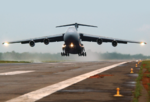Shortround6
Major General
There may be difference between modern fuel bladders and WW II self sealing tanks/bags. I am not sure that putting in non-self sealing bags was a good idea.
Self sealing means it will take more than one hit from a RCMG and after leaking for a short period of time it will seal up the hole/s.
Most AiraCobras were loaded with about 300 rounds per gun for those useless guns, (which were more powerful, faster firing and had a shorter time of flight than the cowl guns in a Zero or the RCMG in the Ki-43) not the full capacity 1000 rounds (which would take 50 seconds to fire at best rate) and that means about 75-78lbs of ammo. That is a whopping 13 US gallons of fuel. the guns were under 95lbs, another 16 gallons (rounded up).
As far as the ammo weight in the nose goes, for 200rpg for two guns, if I have done the math right, the plane has fired 43lb of bullets (worst case/heaviest bullets) and used up around 13.5-14lbs of powder. since it kept the cases in a collector box it kept around 54lbs of fired brass. I have no information on the 37mm ammo.
There may have been a prohibition about flying the plane with no ammo but since the Brass and links account for about 1/2 the ammo weight any test that does not include that amount of ballast may be suspect.
A WW II book on engines and engine installations used 10 cubic ft as an estimate for the amount of room needed for a turbo installation for a 1000hp engine. This does not include the radiators or oil coolers, just the turbo, the intercoolers and the ducting. You are trying to stuff an awful lot of things into that P-51 style duct.
Self sealing means it will take more than one hit from a RCMG and after leaking for a short period of time it will seal up the hole/s.
Most AiraCobras were loaded with about 300 rounds per gun for those useless guns, (which were more powerful, faster firing and had a shorter time of flight than the cowl guns in a Zero or the RCMG in the Ki-43) not the full capacity 1000 rounds (which would take 50 seconds to fire at best rate) and that means about 75-78lbs of ammo. That is a whopping 13 US gallons of fuel. the guns were under 95lbs, another 16 gallons (rounded up).
As far as the ammo weight in the nose goes, for 200rpg for two guns, if I have done the math right, the plane has fired 43lb of bullets (worst case/heaviest bullets) and used up around 13.5-14lbs of powder. since it kept the cases in a collector box it kept around 54lbs of fired brass. I have no information on the 37mm ammo.
There may have been a prohibition about flying the plane with no ammo but since the Brass and links account for about 1/2 the ammo weight any test that does not include that amount of ballast may be suspect.
A WW II book on engines and engine installations used 10 cubic ft as an estimate for the amount of room needed for a turbo installation for a 1000hp engine. This does not include the radiators or oil coolers, just the turbo, the intercoolers and the ducting. You are trying to stuff an awful lot of things into that P-51 style duct.


